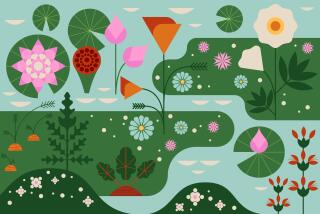A pepper here, a perennial there
- Share via
EVEN AFTER near-record-breaking rains, it’s time to pay attention to watering and other warm-season jobs as spring starts its slide into summer. If you’re near the coast, you have at least two more months of mild spring-like weather ahead, thanks to often-overcast skies. But elsewhere it’s getting warm, and gardening becomes more about maintaining than planting. Sure, you can pour on enough water and get away with planting just about anything, but those who prefer to plant in rhythm with nature often wait until fall to put in trees, shrubs and native plants.
Peppers and more
We all seem to have our favorite pepper, perhaps the most useful summer vegetable: chubby bells, yellow Hungarians, salsa-hot jalapenos, Thai burners. Poblanos have a lot of flesh with a bit of bite. They’re easy to grow -- even in a smattering of shade. They’re best dried, when they’re called anchos.
Other vegetables to plant now include beet, carrot, chayote, cucumber, leaf lettuce, melons, mesclun mixes, New Zealand spinach, onion, pumpkin, radish, squash, sunflower and Swiss chard for those cheesy chard pies.
Hot summer colors
Plant all those sizzling summer annuals, such as ageratum, celosia, bedding dahlia, gloriosa daisy, marigold, petunia, portulaca, verbena and zinnia. In the shade, try bedding begonias, browallia, caladiums, coleus, impatiens, mimulus and forget-me-not. Most spring annuals are finishing up, so there should be room in the garden. These summer blooms are so bright and cheery, they at least deserve a spot in a big pot. When you’re shopping, don’t buy spring-blooming bedding plants that look great right now but may soon decline.
A perennial opportunity
Because so many bloom this month, perennials are plentiful at nurseries and most are a safe bet planted now because the young plants are growing fast and will become established quickly. They will need a lot of water the first month or so, but then you can taper it off. Perennials that bloom in summer include agapanthus, bidens, coreopsis, daylily, gaillardia, heliotrope, lion’s tail (Leonotis), penstemon, salvia, Shasta daisy, tulbaghia, Verbena bonariensis and V. rigida, and yarrow. Note that many are bright yellow, orange or purple, whereas spring flowering perennials are often misty pink or lavender. Fall bloomers include asters, gayfeather (Liatris), helianthus, Japanese anemone, physostegia, Sedum ‘Autumn Joy’ and Tagetes lucida.
Tomato time
Now is the best time to plant so-called “main crop” tomatoes, those big burger-smothering slicers. If you’re close to the coast, plant them against a warm wall, out of cool breezes, and try not to over-water them. Some coastal gardeners get away with biweekly soakings. Inland, tomatoes are much easier to grow but do need more water.
If planting indeterminate types, make sure to provide sturdy and tall supports, such as 6-foot-tall cages made from concrete reinforcing wire with 6-by-6-inch openings, found at building supply stores. When planting tomatoes, dig a hole deep enough so most of the stem is buried, leaving a few sets of leaves on top.
Watering wisdom
Most gardeners find irrigation confusing. Recommendations vary dramatically from locale to locale depending on soil type and climate. The common admonition to water thoroughly or deeply -- found on so many nursery labels -- means to get the water deep into the soil where roots lie, protected against rapid evaporation. For most plants that depth is about 8 to 12 inches down, though trees often have roots 18 to 24 inches deep. Short-lived annuals have roots at the 4- to 5-inch mark.
Bottom line: You can irrigate less often and keep the crown or base of plants drier, dramatically lessening the chance of disease. Too-frequent watering can rot roots, causing wilting.
For plants that need deep irrigation, apply water slowly or it will just run off. It may take some time to soak in. Rather than ordinary sprinkler systems, try bubblers, drip systems, low-flow nozzles or garden hoses on non-lawn areas. At the beginning of this watering season, see if you can’t adjust your practices to suit each plant.






